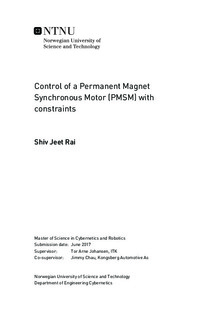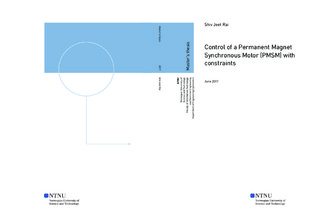| dc.description.abstract | The aim of the thesis is to design and implement a controller that controls the PMSM
without violating the given constraints. This is especially with respect to the battery
current.
Two approaches has been implemented in this paper, where both of themhave shown
to satisfy the given constraints. This was however on expense on the performance
of some of the responses, especially id (t ). As a Surface PMSM (SPMSM) has been
used, a nonzero value on id (t ) only contributes in heat increase in the motor. The
approaches have shown different overall performance of these responses. The simulations
in this paper was carried for a given test case where an angular position reference
was followed. Both approaches have utilized a cascade of P- and PI-controllers,
where one replaced the current controllers with a predictive controller, while the
other utilized saturation blocks.
The predictive controller has been realized by using a Nonlinear Model Predictive
Control (NMPC) structure, as the constraint for the battery current was found to be
nonlinear. In this paper two versions of the NMPC has been looked at, where one
considered constant angular velocity in the prediction horizon and the other did not.
Thiswas motivated by the assumption that a constant velocity in the controller might
have significant reduction on the computational time. Based on the results however,
this paper has shown that including angular velocity in the prediction horizon might
be a better choice. This is in terms of the performance and computational time presented
in the results. However as a framework that does not support c-code generation
has been used, this paper cannot give any direct results on the computational
effort the predictive controllers induce.
The work of this paper should therefore be regarded as an introductory on future
work. This is if it is of interest to use the NMPC presented here for controlling the
motor. The results alone are not of very big significance as the control structure currently
is not deploy-able. However for further work, the results give insights in what
to expect when utilizing a framework that supports c-code generation.
The other approach that have utilized saturation blocks can be used directly. However
some additional tuning might be required if the performance is not sufficient. | |

